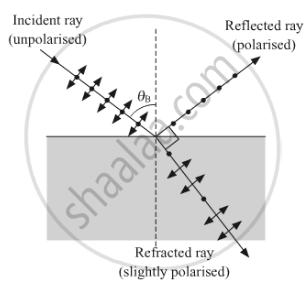Advertisements
Advertisements
प्रश्न
Explain how an unpolarised light gets polarised when incident on the interface separating the two transparent media.
उत्तर

When an unpolarized light falls on the interface separating two transparent media, mostly only those electric vectors get reflected at the boundary which is oscillating along a direction perpendicular to the plane of incidence, hence the reflected ray will be polarised containing only electric vectors. The complete polarisation takes place when the reflected wave and the refracted wave are perpendicular to each other.
APPEARS IN
संबंधित प्रश्न
If the polarising angle for a given medium is 60°, then the refractive index of the medium is.................
What dose a polaroid consist of?
How does one demonstrate, using a suitable diagram, that unpolarised light when passed through a Polaroid gets polarised?
Using the phenomenon of polarisation, show how the transverse nature of light can be demonstrated.
State two uses of Polaroid.
What does a polaroid consist of? How does it produce a linearly polarised light?
What is the difference between polarised light and unpolarised light?
How is polarisation of light obtained by scattering of light?
Can reflection result in plane polarised light if the light is incident on the interface from the side with higher refractive index?
An unpolarized light beam is incident on the polarizer of a polarization experiment and the intensity of light beam emerging from the analyzer is measured as 100 Lumens. Now, if the analyzer is rotated around the horizontal axis (direction of light) by 30° in clockwise direction, the intensity of emerging light will be ______ Lumens.
